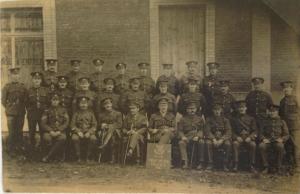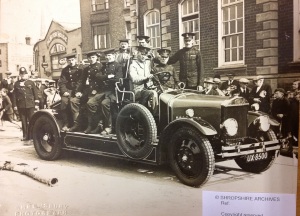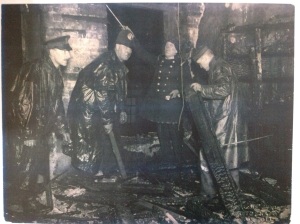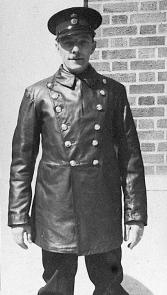Let us Remember……
Leave a commentFebruary 1, 2013 by sfrshistory
On a sunny afternoon in August 1938, Inspector George Henry Faulconbridge entered Shrewsbury Fire Station to demonstrate a Fire Drill for his fellow Fire Fighters. By sunset that day, he was dead.
It was a tragic end to a life which deeply affected the community. Inspector Faulconbridge, a driven and very loyal person, was the second officer of the Shrewsbury Fire Brigade and also a very experienced and well known Senior Police Inspector.
George Henry Faulconbridge the son of George Faulconbridge, a Railway Stoker was born in Lady Wood Birmingham on the 29th May 1888. His mother (Harriet) died in 1891 in premature labour at the early age of 33. At barely three years old at the time Faulconbridge was then brought up by his Cousin Laura in Quinton, Birmingham. When he was 13 his father enlisted him in the army training school as an apprentice wheelwright /carpenter. His army records for the period 1900 to 1914 were lost in the London blitz. This period constituted the “lost years” documentary, but we know that during this time he was at Freshwater on the Isle of Wight, at Gibraltar, Malta and Crete. Being an apprentice wheelwright would ultimately place him in the Army Ordnance Corps (A.O.C.), number S/6704.
After leaving the British Army aged 26 Faulconbridge joined the Shrewsbury Borough Police Force in June 1914, however on the 4th of August 1914 the Declaration of war by the United Kingdom on Germany was announced. Having only been a Police Constable for a few weeks, it was time for Faulconbridge to re-join the army in which he had already spent most of his life and leave his policing aspirations behind – not knowing if he would return or not to further his career.
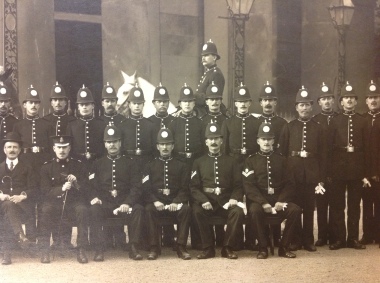
Shrewsbury Borough Police Force Outside St Chads, Shrewsbury. June 1914. Faulconbridge 6th person from right – left back row.
Faulconbridge served in the Royal Army Ordnance Corps in France and Belgium. On the 24th August he joined the British Expeditionary Force (B.E.F) and landed in France and took part in the retreat from Mons. Soon after he received the 1914 Star (colloquially known as the Mons Star). Recipients of this medal also received the British War Medal and the Victory Medal. He also received a Clasp and Roses, awarded to those who operated within range of enemy mobile artillery. When the ribbon bar was worn alone, i.e. on a uniform, the recipients of the clasp to the medal wore a small silver rosette on the ribbon bar. During his time in the War Faulconbridge attained the rank of Sergeant.
Whilst on leave in 1917 he married local Shrewsbury girl Ethel Mary Pugh.
Men like Faulconbridge talked very little of wartime exploits, but we know that he was no stranger to death – however it occurred. On one occasion his son Robert understood from him that men to his immediate right and left were killed by shrapnel from an exploding shell – he fortunately was unharmed.
Once the war was over in November 1918 he came back to his new wife and also re-joined the Shrewsbury Borough Police Force which was undergoing a radical new change.
A Fire Engine arrived in Shrewsbury in April 1918 and was housed in the Old Market Hall with access onto Claremont Street. It was decided by the new Shrewsbury Borough Council that they would take charge of the local Fire Brigade which would be run by the Shrewsbury Borough Police Force.
Faulconbridge showed a great enthusiasm to be a part of the new Fire Brigade. Most fires were haystacks in large Dutch barns, which took days and nights to extinguish. The firefighters kept working at it until the fire was out which was, and still is exhausting work.
Always trying to improve and help others he was promoted to acting sergeant in 1919 and then again to inspector in 1927. No doubt experiences of wartime death stood him in good stead when he was appointed The Coroner’s Officer as he was called upon to deal with death which occurred in all manner of ways.
In 1935 he was awarded the King George V Jubilee medal (All his medals, plus the miniature set, and Tug-of-War cups have been sent to the R.A.O.C. Museum, at Deepcut in Surrey).
During his career he lived with his wife and four children adjacent to the Old Shrewsbury Police Station, at 23a Swan Hill. The Chief Constable, Frank Davies lived above the Police Station, as did Sgt. Teddy Talbot. In his spare time away from the Police and the Fire Brigade he was a very fit and active man who played football on a regular basis until his late 40’s. He also enjoyed playing Tennis, Cricket and Bowls.
One of Inspector Faulconbridge’s life changing experiences happened just months before he died. In January 1938 he was entrusted to look after a very important visitor to Shrewsbury, Haile Selassie the Emperor of Ethiopia. The visit ran smoothly and Inspector Faulconbridge on request took the Emperor to his own barbers for a haircut. His son Robert Faulconbridge who was 14 at the time recalls “he wasn’t the sort of man to get excited but he was bubbling that day when he got home from work, he told us all to shake his hand before he washed it because he had just shaken hands with the great Haile Selassie.”
Inspector Faulconbridge was the 2nd Officer of the Shrewsbury Fire Brigade and had been demonstrating different fire drills in front of his men for over 11 years, today the 24th of August 1938 should have been just another ordinary day at the new Fire Station which was at Cross Hill. Officers on the drill yard were discussing the Davy Descender which is a device that is used to lower a person from height using a geared braking mechanism which ensures a controlled rate of descent irrespective of weight or drop. One of the men asked “could two men come down on it?” Inspector Faulconbridge replied “yes, I will show you” eager to train his men and set a good example Inspector Faulconbridge and Fireman Jones climbed a ladder about 26 feet above the ground – Fireman Jones attached the Davy sling under his arms and Inspector Faulconbridge held onto his shoulders, they both let go of the ladder and quickly dropped about 6 feet when suddenly there was a jerk in the rope, Inspector Faulconbridge lost his grip and fell the rest of the way down catching his feet on a window sill spinning him round and causing him to land head first on the ground. He was rushed to the Royal Salop Infirmary but later that night died of his injuries.
His widow Ethel, two sons and two daughters were left devastated by the tragic accident which changed their lives completely. Mrs. Faulconbridge was given 2 weeks to find a new home for her family as it was owned by the Police Station. Robert Faulconbridge, the youngest son aged just 14 and a free spirit of a boy was obliged to work immediately at the Chatwood Safe factory in Harlescott so that he could bring in some much needed money for the family.
Robert Faulconbridge now aged 89 and living with his wife Brenda in Cruckmeole near Hanwood recalls fond memories of his father and also his life growing up in Shrewsbury in the 1930s. “It was completely different in those days; we had so much freedom and always felt safe not just because we lived opposite the police station but throughout the town”. When looking at old photos of his father Robert is able to name every single Police Constable and exclaims “I grew up with them all, they were all friends with my father and most stayed in touch after he died”.
In an odd coincidence Inspector Faulconbridge joined the B.E.F. on 24th August 1914, and 24 years later, on the 24th August 1938 he lost his life.
Robert and Brenda were invited to plant a tree at the National Memorial Arboretum at Alrewas, in Staffordshire. The tree is planted in an area called The Beat, part of the 150 acre site which is dedicated to those who gave their lives serving their country.
Shropshire Fire and Rescue Service would also like to pay tribute to Inspector Faulconbridge by displaying a framed copy of the newspaper article from the time of the accident and also a copy of the plaque that is attached to the tree at the National Memorial Arboretum. This will be displayed in the Reception Meeting room at the Shrewsbury Headquarters.
Inspector George Henry Faulconbridge is currently the only Firefighter who has tragically lost their life in the course of duty in Shropshire.
For more photos of Inspector Faulconbridge please follow this link to our Flickr account album. http://www.flickr.com/photos/sfrshistory/sets/72157632717554122/
BBC Radio Shropshire Story and Interview:
https://www.dropbox.com/s/rs1b1701r1jr5n4/FIREFIGHTER%20FULL%20PKG.mp3?m
https://www.dropbox.com/s/09vcw8pu24chhvh/FIREFIGHTER%20SISTER.mp3?m

